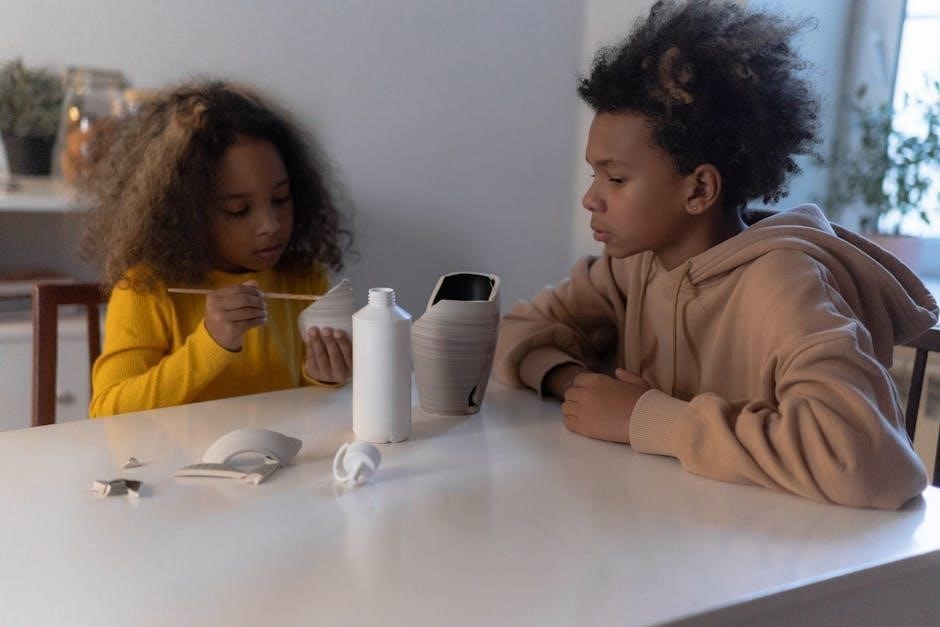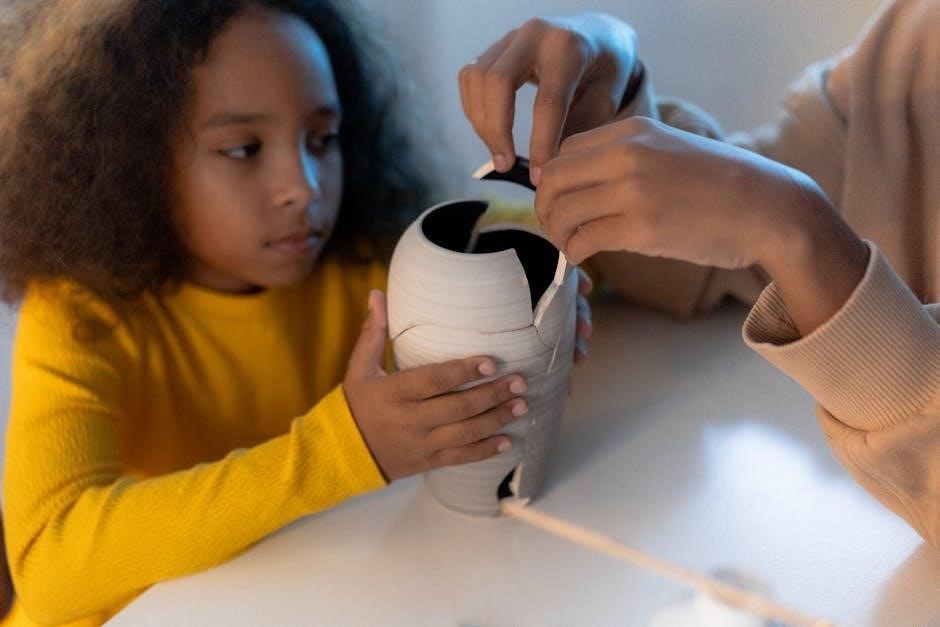Empowering children to solve their own problems fosters independence and resilience. By teaching problem-solving skills and emotional regulation, parents guide kids toward confident decision-making and self-reliance.
Why Teaching Problem-Solving Skills is Essential
Teaching children to solve problems independently is crucial for their development. It fosters resilience, critical thinking, and confidence, enabling them to navigate life’s challenges effectively. By learning to identify problems, brainstorm solutions, and evaluate outcomes, kids develop essential life skills. Problem-solving abilities also enhance academic performance and social interactions, as children learn to approach obstacles calmly and creatively. Moreover, these skills promote emotional regulation, helping kids manage frustration and stress. Equipping children with problem-solving strategies empowers them to take ownership of their decisions and mistakes, fostering a growth mindset. This foundation is vital for their long-term success and ability to thrive in an ever-changing world.
The Role of Parents and Caregivers in Fostering Independence
Parents and caregivers play a pivotal role in fostering a child’s independence by guiding them through problem-solving processes. By encouraging open communication and active participation, adults help children build confidence and self-reliance. Using supportive methods like positive timeouts and reflective practices, parents can create a safe environment where kids feel comfortable addressing challenges. Modeling problem-solving strategies and offering age-appropriate guidance enables children to develop critical thinking and emotional regulation. Caregivers should avoid solving problems for their children, instead acting as mediators who empower kids to explore solutions independently. This supportive approach helps children develop a sense of responsibility and self-worth, laying a strong foundation for future success. Through consistent encouragement and patience, parents can nurture a child’s ability to handle life’s obstacles with resilience and determination.

The Problem-Solving Process for Children
Teach kids to identify problems, brainstorm solutions, and reflect on outcomes. Guide them through steps like recognizing issues, exploring options, and evaluating results to build confidence.
How to Help Kids Identify and Acknowledge Problems
Encourage children to recognize and accept challenges by creating a supportive environment. Use open-ended questions like “What do you think is the issue?” or “How do you feel about this?” to help them articulate their concerns. Teach them to label emotions and understand the impact of their actions. Guide them to identify problems clearly, such as “I can see you’re upset because…” Validate their feelings to build trust and confidence. Avoid dismissive language, and instead, focus on empowering them to take ownership of their challenges. This approach fosters self-awareness and prepares them to tackle problems independently. By modeling problem-acknowledgment, you help them develop a growth mindset and resilience.
Step-by-Step Guide to Teaching Problem-Solving Strategies
Teach children a structured approach to problem-solving by breaking it into manageable steps. Start by helping them define the issue clearly, encouraging them to ask questions like, “What’s the problem?” or “Why is this happening?” Next, guide them to brainstorm possible solutions without judgment. Role-play different scenarios to help them visualize outcomes. Encourage them to choose a solution and create a simple plan, such as listing steps they can take. Support them in implementing their plan and reflecting on the results. Praise effort and persistence, even if the outcome isn’t perfect. This process builds critical thinking and self-confidence, helping them approach challenges methodically and independently.
Age-Appropriate Techniques for Different Stages
Adapt problem-solving strategies to match your child’s developmental stage, ensuring methods are engaging and effective for their age, from preschoolers to teenagers.
Teaching Preschoolers to Solve Problems Independently
Preschoolers can learn independence through guided exploration. Encourage them to identify problems and brainstorm solutions using simple, age-appropriate language. Positive reinforcement and patience support their growth.
Helping Teenagers Navigate Complex Issues
Teenagers face unique challenges, such as social pressures, self-identity, and emotional conflicts. To help them navigate these issues, foster open dialogue and active listening. Encourage them to express their thoughts and feelings without judgment, building trust and confidence. Guide them through problem-solving steps: identifying the problem, brainstorming solutions, and evaluating outcomes. Teach them to weigh pros and cons and consider long-term effects. Encourage independence by letting them take ownership of decisions, even if mistakes occur. Mentor them on communication and conflict resolution, helping them express needs clearly and respectfully. Balance support with allowing them to learn from experiences, fostering resilience and maturity. By equipping teenagers with these skills, they develop the ability to handle complex issues effectively and responsibly.

Emotional Regulation and Self-Control
Teach children to manage emotions and develop self-control through open conversations and calming techniques. Guide them to identify feelings, express them constructively, and build resilience for life challenges.
Strategies to Help Kids Manage Their Emotions
Helping children manage emotions involves teaching them to recognize, express, and regulate their feelings. Start by modeling emotional awareness and using age-appropriate language to label emotions. Encourage open conversations where kids feel safe to discuss their feelings without judgment. Introduce calming techniques like deep breathing, counting, or drawing to help them soothe themselves. Teach problem-solving skills to address the root causes of emotional distress. Positive reinforcement, such as praising effort and progress, can build confidence and encourage healthy emotional expression. Consistency and patience are key, as mastering emotional regulation is a gradual process that supports long-term mental well-being and resilience.
Developing Self-Regulation Skills in Children
Developing self-regulation skills in children involves teaching them to manage their behavior and emotions effectively. Start by setting clear expectations and using visual reminders to reinforce positive behavior. Encourage self-monitoring by introducing tools like checklists or reflection time, allowing children to assess their own actions. Provide consistent feedback, focusing on both achievements and areas for improvement, to guide their development. Offer choices to foster a sense of control, which can reduce tantrums and meltdowns. Incorporate activities that naturally require patience and sharing, such as board games, to practice self-regulation in a fun way. Use visual timers to help them manage transitions and time, and establish consistent routines to provide a sense of predictability. By creating a supportive environment with practical strategies, you help children build independence and self-awareness, essential for their emotional and behavioral growth.

Communication and Reflective Practice
Open communication and reflective practice empower children to articulate their thoughts and feelings, fostering critical thinking and problem-solving. Active listening and thoughtful questioning guide them toward self-awareness and confidence.
Using Open-Ended Questions to Encourage Critical Thinking
Open-ended questions are a powerful tool to nurture critical thinking in children. By asking questions like “What do you think could happen if…” or “How do you feel about this situation?,” parents and educators encourage kids to explore their thoughts and ideas deeply. These questions cannot be answered with a simple “yes” or “no,” prompting children to reflect, analyze, and articulate their reasoning. For younger children, questions like “What do you see here?” or “Why do you think this happened?” spark curiosity and creativity. As children grow, more complex questions like “What are the pros and cons of this decision?” help them develop problem-solving skills. Open-ended questions foster independence, self-confidence, and the ability to think critically, preparing kids to tackle challenges effectively.
Reflective Practice in Parent-Child Relationships
Reflective practice strengthens parent-child relationships by encouraging mindfulness and self-awareness. Parents who reflect on their interactions with their children can better understand their child’s needs and emotions. This involves acknowledging both successes and challenges, fostering a supportive environment for growth. Reflective practice helps parents identify patterns in their child’s behavior and respond thoughtfully rather than react impulsively. By regularly reflecting, parents can adapt their strategies to meet their child’s evolving needs, promoting emotional intelligence and resilience. This mindful approach also models healthy self-reflection for children, teaching them to think critically about their actions and feelings. Ultimately, reflective practice cultivates a deeper understanding and connection, empowering both parents and children to navigate life’s challenges together.

Positive Discipline and Supportive Environments
Creating a safe, supportive environment with positive discipline fosters self-esteem and resilience in children. Parents can guide behavior without punishment, encouraging responsibility and emotional well-being.
Implementing Positive Discipline Methods
Positive discipline focuses on guiding children through kindness and clear communication. Parents can set age-appropriate boundaries and use timeouts constructively to help kids reflect on their actions. Encouraging open dialogue and active listening fosters mutual respect and understanding. By modeling positive behavior and offering choices, parents empower children to make better decisions independently. This approach avoids derogatory language and emphasizes empathy, helping children develop self-control and problem-solving skills. Consistency is key, ensuring children feel secure while learning from their mistakes. Positive discipline not only addresses misbehavior but also nurtures emotional health and resilience, fostering a supportive home environment.
Creating a Safe and Supportive Home Environment
A safe and supportive home environment is crucial for children to thrive and develop problem-solving skills. Parents can create this by ensuring emotional and physical safety, allowing kids to feel secure and valued. Open communication and active listening help children express their concerns without fear of judgment. Consistency in routines and clear, age-appropriate expectations provide stability. Encouraging independence while offering guidance fosters confidence. Parents should model positive behavior and provide opportunities for children to practice self-regulation. A supportive environment also involves addressing triggers of problem behavior and helping children understand their emotions. By focusing on strengths and promoting a positive sense of self, parents help children build resilience and navigate challenges effectively.

